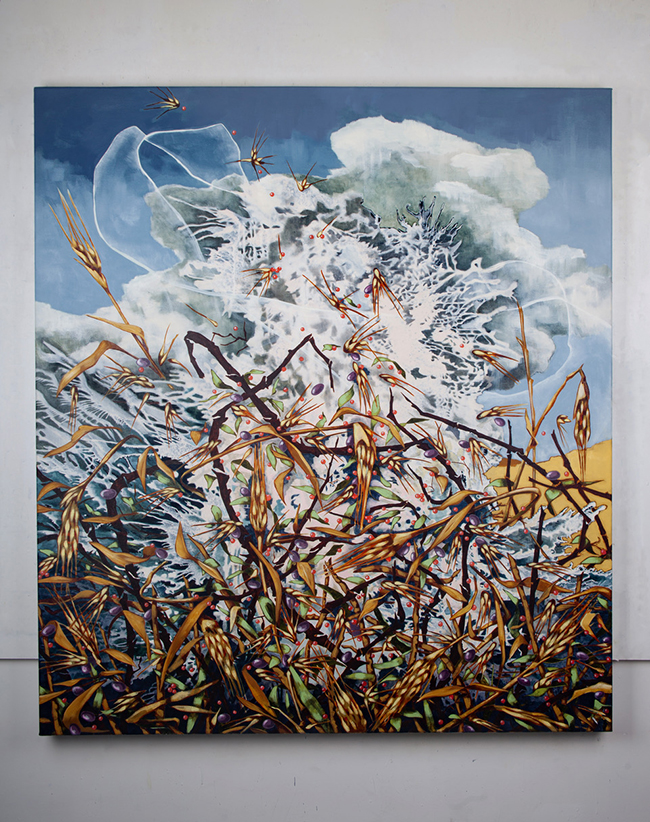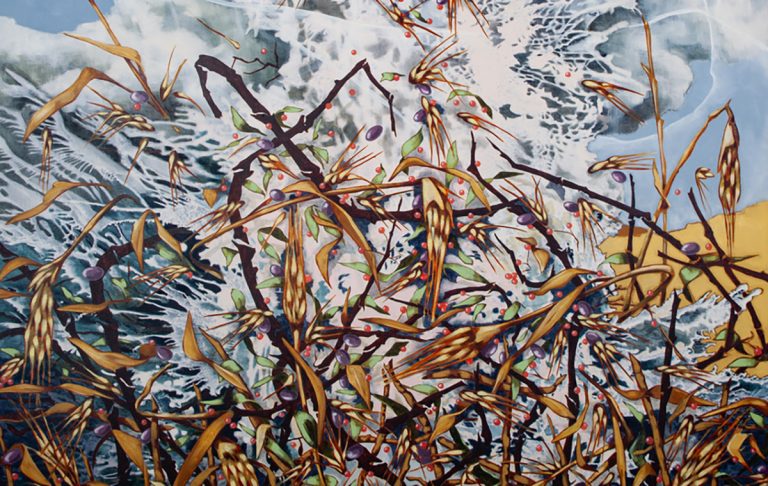Laura Corallo-Titus is a California-based painter whose work explores themes of climate change and humanity’s evolving perception of nature. As a mid-career artist, she has exhibited her work in national group shows and solo exhibitions at various venues, including the San Jose City College Art Gallery, Patricia Sweetow Gallery, and internationally at Tapir Gallery in Berlin. Her art also holds a place in several public collections, such as The Monterey Museum and The Crocker Museum, reflecting her commitment to conversations around the environment and its depiction in contemporary art. In her paintings, Corallo-Titus grapples with pressing ecological issues, aiming to reframe how we see and engage with landscapes under the strain of climate crises. Her works offer more than scenes of nature; they are visual meditations on the fragility of our ecosystems and a reminder of the uncertain future of the land we depend on.

In Ceres (2024), Corallo-Titus brings this vision to life with a painting that layers myth, landscape, and environmental critique into a single, tense composition. The piece centers on Ceres, the Roman goddess of agriculture and fertility, traditionally associated with the bounty of the earth and the cycles of planting and harvest. But in Corallo-Titus’ rendering, the presence of Ceres is symbolic rather than literal—she appears almost as a phantom, her form reduced to the ethereal suggestion of a veil amidst an unruly landscape. The choice to invoke Ceres here is both historical and sharply relevant, linking ancient agrarian deities to today’s fears about food security and climate change.
The painting, a 54”x48” oil on canvas, is rich in textures and contrasts. Corallo-Titus paints with a subtle, muted palette that mirrors the calm of an idealized, pastoral scene, but the tranquility is undercut by darker elements. A soft horizon line stretches across the middle of the composition, populated with gentle, rolling fields. The agrarian beauty here feels almost dreamlike, lulling viewers into a sense of peace before revealing the deeper disturbances Corallo-Titus has layered beneath. Dark clouds swirl above, storming in from the edges, suggesting a climate no longer predictable or mild. Rising seas gnaw at the land from below, eroding the foundation of this once-stable world.
The brilliance of Ceres lies in this careful tension—the landscape appears both timeless and transient, as though suspended on the edge of ruin. The goddess Ceres, represented by her veil, becomes a haunting symbol of what has been lost and what is at risk. For millennia, Ceres has symbolized abundance and the security of harvests, but here, her veil floats uncertainly, as if caught in a fierce wind, ready to be blown away. Corallo-Titus invites viewers to consider that, just as Ceres cannot protect this threatened land, the mythic promises of nature’s resilience may not hold against the destructive forces unleashed by climate change.
Corallo-Titus’ technique in Ceres supports the painting’s thematic complexity. Her brushwork is meticulous yet expressive, with soft, blended strokes that shift into harsher, textured forms around the storm clouds and encroaching seas. The visual shift in technique mirrors the contrast between the calm of the pastoral and the violence of a changing climate. This duality resonates, evoking both reverence for natural beauty and a fear of its vulnerability. In the world of Ceres, nature’s role is ambiguous: it’s a source of life and sustenance but also something dangerously beyond human control.
Through Ceres, Corallo-Titus urges viewers to confront the deeper implications of climate change—not merely as a series of scientific facts but as a reshaping of the natural world that has been at the heart of human imagination for centuries. The painting is a reminder that climate change is not just about numbers and predictions; it’s a cultural rupture, one that severs our ties to centuries-old beliefs in the earth’s capacity for renewal and growth. The mythical Ceres can no longer promise bounty when her veil is all that remains.
Laura Corallo-Titus has crafted a work that’s both a commentary and a warning. Ceres embodies the fear and uncertainty that have become intrinsic to our understanding of nature in an era of environmental crisis. Through this piece, Corallo-Titus channels the beauty of the natural world while making a poignant statement about its fragility. She paints a myth that speaks to modern anxieties, a vision where nature’s abundance is as impermanent as a goddess’ veil in the wind.

